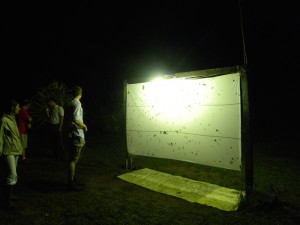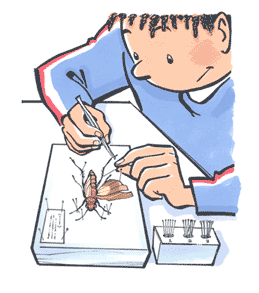Building an insect collection requires specific protocol, methods and materials for insect collection and related data collection, specimen display, species determination and canning. This article and the following ones are therefore intended to show you how I proceed.
How to catch insects?
To catch insects, several techniques and materials exist, depending on the type of insects you are looking for and the habitat you are in. I present you some examples here
caption id=”attachment_847″ align=”alignright” width=”226″] Use of mower net (Illustration J. Goldstyn – Montreal Insectarium)[/caption]
Use of mower net (Illustration J. Goldstyn – Montreal Insectarium)[/caption]
Le filet fauchoir : this net is used to collect insects found in grasses and bushes. It is ideal for catching insects such as Orthopterans (locusts, grasshoppers and crickets), Beetles or Heteropterans (bedbugs), insects that fly little or nothing. Its use is simple, it is a question of mowing the plants from right to left on a small surface, to look at what fell inside and to collect what we are interested in (see illustration). There are no real size criteria or manufacturing materials, but it must be solid, especially the net, to avoid tearing and allow mowing even in dense vegetation.
caption id=”attachment_852″ align=”alignleft” width=”216″] Rotation movement to enclose the insect (Illustration J. Goldstyn – Insectarium Montréal)[/caption]
Rotation movement to enclose the insect (Illustration J. Goldstyn – Insectarium Montréal)[/caption]
Le filet à papillon : this net is used for
capture flying insects such as Lepidoptera (butterflies), Odonata (dragonflies), Diptera (flies) and Hymenoptera (wasps and bees). Its use is as simple as the mower net, it is a question of making the insect penetrate in the net and to close again the net to prevent that the insect does not leave (see illustration). On the contrary, this net is lighter to be more manageable and not to damage insects, but also deeper not to damage butterflies for example. The size of the net and handle can be large and long depending on what you want to capture. Many of these nets have a telescopic handle, up to 4m.
caption id=”attachment_856″ align=”alignright” width=”150″] Beating and using a Japanese umbrella (Source : CIRAD – A. FRANCK)[/caption]
Beating and using a Japanese umbrella (Source : CIRAD – A. FRANCK)[/caption]
Le battage : this technique consists in hitting the branches and leaves of trees and shrubs to make the insects that hide there fall and to receive them on a support position under the plant. For that, the material is simple, a stick and a tablecloth of reception like the “Japanese umbrella” are necessary (see photo). The threshing is not suitable for flying and jumping insects, but for small insects such as caterpillars, bugs, beetles and also spiders.
L’aspirateur à bouche : This device allows the capture of very small insects moving quickly and that it is difficult to catch by hand or with pliers. The principle is to suck the insect into a container. The vacuum cleaner is composed of a hermetically sealed container, from which 2 flexible hoses leave, one of which is covered with a grid or net inside the container to avoid the passage of the insect in the mouth (see photo). Many models exist, it is possible to manufacture it yourself, or to buy it directly from a retailer.
caption id=”attachment_859″ align=”alignleft” width=”246″] Sample vacuum cleaner (Source : CIRAD – A. FRANCK)[/caption]
Sample vacuum cleaner (Source : CIRAD – A. FRANCK)[/caption]

Le piège au sol : It is used to capture live insects on the ground and in soil litter such as carabid beetles (Carabidae), staphylins (Staphylinidae), ants (Formicidae) or dung beetles (Scarabaeidae). It is a question of positioning a pot in the ground so that its opening is at ground level. It will be placed in the bottom of the jar an attractive food. To prevent rainwater from running into the pot, a wooden board, or a tile for example, should be installed 5cm above the opening of the pot and the ground.

Le piège lumineux : This method captures nocturnal insects, flying and crawling, whose activity period is between nightfall and midnight. As light attracts them, the idea is to stretch a white sheet to the ground and place a high light source a few centimetres from the sheet. Insects are especially attracted by Ultra-Violet wavelengths, so mercury vapour bulbs or fluorescent tubes are the most suitable. The practice of the light trap is more effective during hot and windless nights, also, avoid full moon nights. The sheet can be installed in any habitat (forest, meadow, clearings…).
Conditioning captured insects
As soon as the insects are caught in the field, they are killed and placed in alcohol tubes.
For butterflies and dragonflies, the alcohol tube is not suitable, on the one hand because of their morphology (large wings) and on the other hand, because of the fragility of butterfly wings that are covered with scales. The killing of these insects will be done in the freezer once back from the ground. The best technique for their transport is that of envelopes (or papillotes). It consists in placing the butterfly or dragonfly in a sheet of paper that will be folded to keep the insect still with the wings folded back. These papillotes can be made quickly or purchased from any entomological equipment vendor (see illustration).

I am, of course, at your disposal for any questions, requests for advice, tips and/or expertise. Do not hesitate to contact me here. Looking forward to reading and helping you!
Recommendation of books on this theme:
– Well start entomology : Insects


